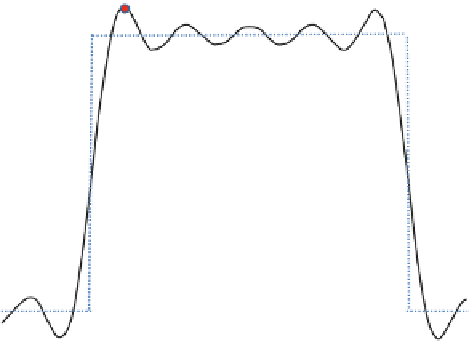Graphics Reference
In-Depth Information
Fig. 7.13
Gibbs
phenomenon, where the
dotted curve
is the original
samples and the
solid curve
is
the reconstructed samples.
Local peaks, convex corners,
concave corners, and local
valleys are marked with
solid
circles
and none-of-the-above
samples with
empty circles
.
Reproduced with permission
from [
13
], © 2012 IEEE
a
a
a
a
c
b
c
c
c
b
b
b
Fig. 7.14
Four 1-D directional patterns for EO sample classification: horizontal (EO class
D
0),
1), 135
ı
diagonal (EO class
2), and 45
ı
diagonal (EO class
vertical (EO class
D
D
D
3). Repro-
duced with permission from [
13
], © 2012 IEEE
concave edges/corners, and local valleys are marked with solid circles and none-
of-the-above samples with empty circles. One can observe from the figure that the
distortion can be reduced by applying negative offsets to local peaks and convex
corners and positive offsets to concave corners and valleys. The operation of the
edge offset is based on this observation. EO uses four one-directional patterns
for sample classification: horizontal, vertical, 135
ı
diagonal, and 45
ı
diagonal, as
shown in Fig.
7.14
, where label “c” represents the current sample and labels “a” and
“b” represent the two neighboring samples. These four sample patterns form four
EO classes. Only one EO class can be selected for each CTB that enables EO. Based
on the rate-distortion optimization, one EO class is chosen and an index indicating
which EO class is selected is signaled in the bitstream.
For a given EO class with the specific direction, each sample inside the CTB
is classified into one of five categories. The current sample value, labeled as “c”,
is compared with its two neighbors along the selected 1-D pattern. The category
classification rules for each sample are summarized in Table
7.2
. Categories 1 and
4 are associated with a local valley and a local peak, respectively, along the selected
1-D pattern. Categories 2 and 3 are associated with concave and convex corners,
respectively. If the current sample does not belong to any of EO categories 1-4, it is
assigned to category 0 and SAO is not applied. Note that the categories are mutually
exclusive and a sample can belong only to one category.









































